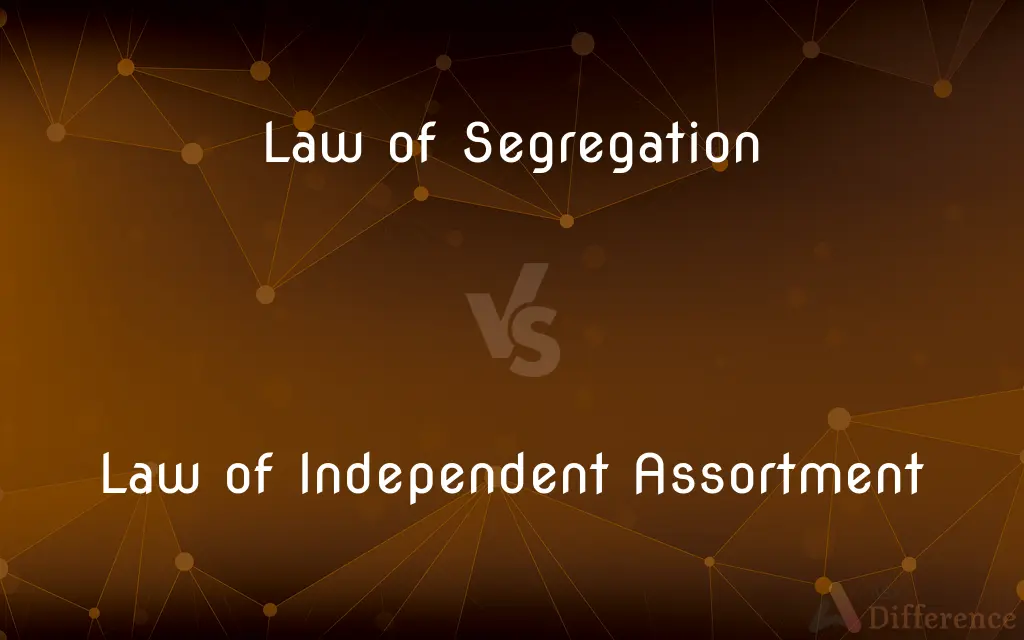Law of Segregation vs. Law of Independent Assortment — What's the Difference?
Edited by Tayyaba Rehman — By Fiza Rafique — Published on December 10, 2023
The Law of Segregation states that allele pairs separate during gamete formation; the Law of Independent Assortment asserts that genes for different traits assort independently.

Difference Between Law of Segregation and Law of Independent Assortment
Table of Contents
ADVERTISEMENT
Key Differences
The Law of Segregation is one of the fundamental principles that describe how traits are inherited from one generation to the next. It elucidates that each organism has two alleles for each trait, and these alleles segregate, or separate, during gamete formation. In contrast, the Law of Independent Assortment pertains to the random distribution of alleles for different genes during gamete formation.
Expanding on the Law of Segregation, it means that each gamete will carry only one allele for each trait. When two gametes merge during fertilization, the offspring will receive one allele from each parent, forming the allele pair. On the other hand, the Law of Independent Assortment emphasizes that the separation of alleles for one gene doesn't influence the separation of alleles for another gene.
Delving deeper, the Law of Segregation stems from Mendel's observations on pea plants, where he noted that the two versions of a gene segregate from each other into the gametes. In essence, offspring inherit one version from each parent. Meanwhile, the Law of Independent Assortment was also derived from Mendel's experiments, where he discovered that different gene pairs segregate independently in the formation of gametes.
To simplify, the Law of Segregation focuses on how individual alleles segregate during gamete formation, ensuring each gamete has one allele for a particular trait. The Law of Independent Assortment delves into how different gene pairs assort independently, without any influence from other gene pairs during gamete formation.
In summary, while both the Law of Segregation and the Law of Independent Assortment describe the behavior of genes during gamete formation, the former pertains to the segregation of individual alleles, and the latter addresses the independent assortment of different gene pairs.
ADVERTISEMENT
Comparison Chart
Origin
Based on Mendel's pea plant experiments
Also derived from Mendel's experiments
Focus on
Individual alleles
Different gene pairs
Behavior in Gametes
Each gamete gets one allele for a trait
Alleles of different genes assort independently
Influence of Other Genes
Not applicable
No influence of one gene's assortment on another
Result in Offspring
Offspring inherit one allele from each parent
Offspring inherit combinations of alleles independently
Compare with Definitions
Law of Segregation
Mendel's first law describing the distribution of allele pairs.
Mendel's pea plant experiments supported the Law of Segregation.
Law of Independent Assortment
Mendel's second law about the behavior of different gene pairs.
Through dihybrid crosses, Mendel uncovered the Law of Independent Assortment.
Law of Segregation
A genetic rule detailing how alleles separate in forming gametes.
The Law of Segregation is foundational in understanding genetic inheritance.
Law of Independent Assortment
A principle stating genes for different traits assort independently.
The Law of Independent Assortment demonstrates the random combination of genes in offspring.
Law of Segregation
The idea that two alleles for a trait segregate during meiosis.
Meiosis ensures the Law of Segregation is maintained in reproductive cells.
Law of Independent Assortment
A rule stating that genes separate without influence from other genes.
Genetic diversity is partly attributed to the Law of Independent Assortment.
Law of Segregation
A principle stating that allele pairs separate during gamete formation.
The Law of Segregation explains why offspring inherit one allele from each parent.
Law of Independent Assortment
The concept that allele pairs separate independently during gamete formation.
Multiple traits inherited are due to the Law of Independent Assortment.
Law of Segregation
A concept asserting that each gamete carries one allele for each trait.
According to the Law of Segregation, allele pairs split up in gametes.
Law of Independent Assortment
An idea asserting no influence of one gene's assortment on another.
The Law of Independent Assortment dictates the random distribution of inherited traits.
Common Curiosities
Did Mendel discover both the Law of Segregation and Law of Independent Assortment?
Yes, both the Law of Segregation and the Law of Independent Assortment were derived from Mendel's pea plant experiments.
Can two genes on the same chromosome follow the Law of Independent Assortment?
Typically, genes close together on a chromosome don't perfectly adhere to the Law of Independent Assortment due to genetic linkage, but the Law of Segregation still applies.
What does the Law of Segregation detail?
The Law of Segregation states that allele pairs separate during gamete formation, with each gamete receiving one allele.
How does the Law of Independent Assortment function?
The Law of Independent Assortment posits that genes for different traits assort independently during gamete formation.
How do the two laws differ?
The Law of Segregation focuses on individual alleles, while the Law of Independent Assortment emphasizes the independent behavior of different gene pairs.
Are there exceptions to these laws?
Yes, there can be exceptions, especially to the Law of Independent Assortment when genes are linked on the same chromosome, but the Law of Segregation generally holds true.
Which law would explain why two traits are inherited together more often than expected?
If two traits are inherited together frequently, it could be a deviation from the Law of Independent Assortment due to genetic linkage.
Can an organism's genotype be predicted solely based on these laws?
These laws can help predict genotypic ratios, but the exact genotype also depends on specific allele combinations and other genetic factors.
Why is the Law of Independent Assortment not always strictly observed?
The Law of Independent Assortment may not always be strictly observed due to genetic linkage or genes being close together on the same chromosome.
Why is the Law of Segregation fundamental in genetics?
The Law of Segregation forms the basis for understanding how traits are inherited and how alleles separate in gametes.
How does the Law of Independent Assortment contribute to genetic diversity?
The Law of Independent Assortment allows for various combinations of alleles, contributing to genetic diversity in offspring.
How do these laws explain the 9:3:3:1 phenotypic ratio in a dihybrid cross?
The ratio arises from both the Law of Segregation (each trait segregating into alleles) and the Law of Independent Assortment (each trait assorting independently).
Do both laws apply during meiosis?
Yes, both the Law of Segregation and Law of Independent Assortment are observed during meiosis when gametes are formed.
How are the laws observed in a dihybrid cross?
A dihybrid cross showcases both the Law of Segregation (as each trait segregates) and the Law of Independent Assortment (as traits assort independently).
Are these laws applicable to all organisms?
While the principles behind the Law of Segregation and Law of Independent Assortment are widely observed, there can be exceptions in some organisms or under certain conditions.
Share Your Discovery

Previous Comparison
Buen Dia vs. Buenos Dias
Next Comparison
MUV vs. SUVAuthor Spotlight
Written by
Fiza RafiqueFiza Rafique is a skilled content writer at AskDifference.com, where she meticulously refines and enhances written pieces. Drawing from her vast editorial expertise, Fiza ensures clarity, accuracy, and precision in every article. Passionate about language, she continually seeks to elevate the quality of content for readers worldwide.
Edited by
Tayyaba RehmanTayyaba Rehman is a distinguished writer, currently serving as a primary contributor to askdifference.com. As a researcher in semantics and etymology, Tayyaba's passion for the complexity of languages and their distinctions has found a perfect home on the platform. Tayyaba delves into the intricacies of language, distinguishing between commonly confused words and phrases, thereby providing clarity for readers worldwide.













































